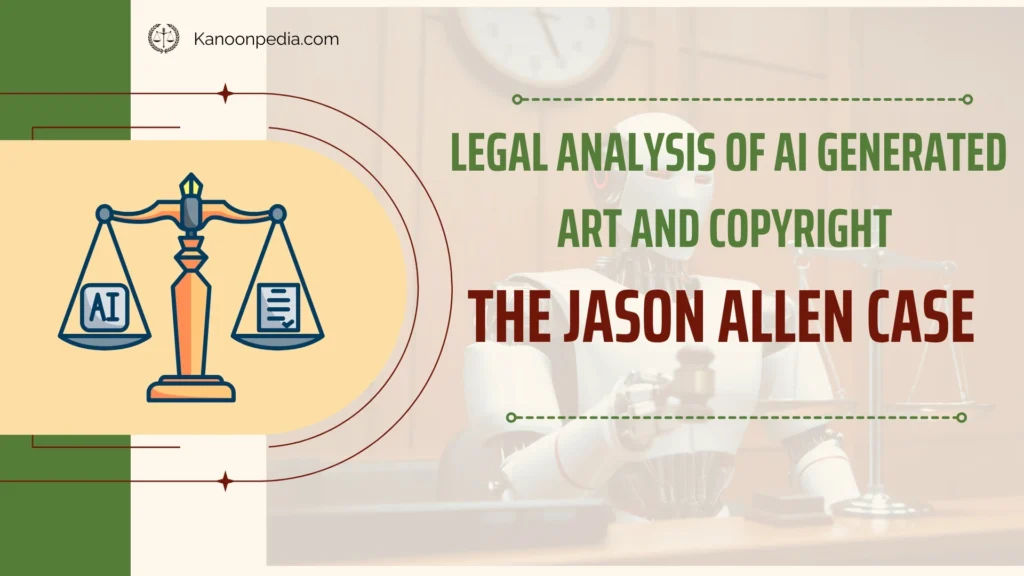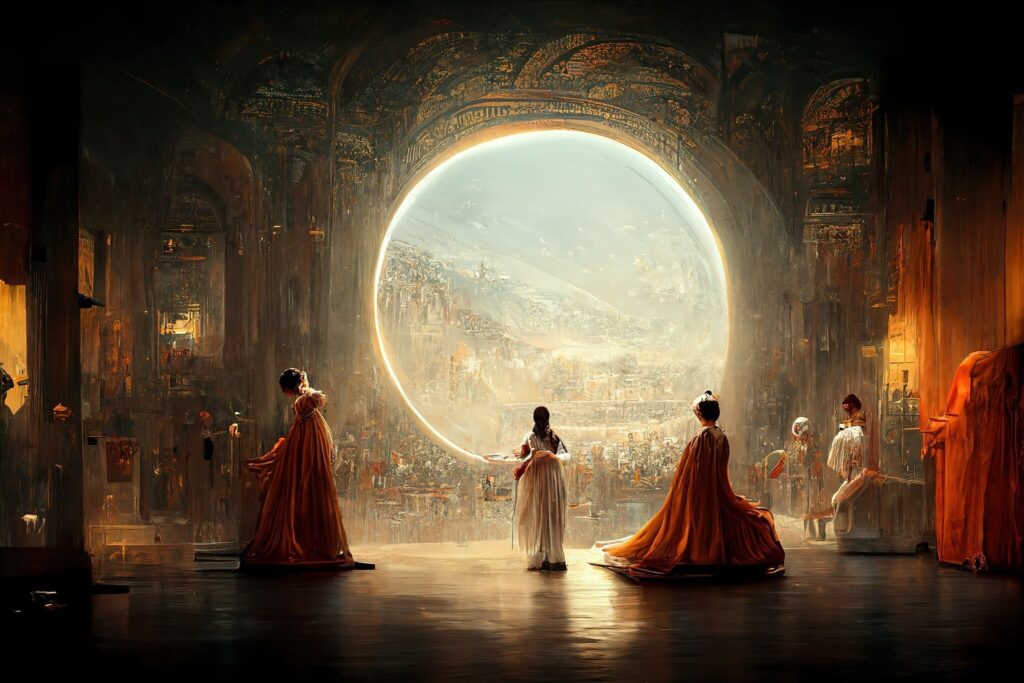Key Takeaway:
Under current U.S. copyright law, AI-generated works lacking sufficient human authorship ineligible for protection, and the Legal Analysis of AI Generated Art and Copyright The Jason Allen Case crystallizes the requirement for meaningful human creative contribution.

Table of Contents
Introduction to Legal Analysis of AI Generated Art and Copyright The Jason Allen Case

The intersection of artificial intelligence and intellectual property has sparked heated debates across legal, artistic, and academic communities. Central to this discourse is the Legal Analysis of AI Generated Art and Copyright The Jason Allen Case, which examines the first high-profile challenge to the U.S. Copyright Office’s refusal to register an AI-created work. This blog offers an authoritative, in-depth examination for students and researchers, exploring the factual background, doctrinal framework, key judicial rulings, evolving policy positions, and the broader implications for creative industries.
Legal Analysis of AI Generated Art and Copyright The Jason Allen Case – Factual Background
In August 2022, Jason M. Allen, a video game designer from Pueblo West, Colorado, submitted Théâtre D’opéra Spatial—an image generated via Midjourney AI with over 600 iterative prompts and subsequent editing in Photoshop—to the Colorado State Fair’s digital art competition. Allen openly disclosed the AI’s role, won first place, and received a $300 prize . Controversy erupted when it became public that the work was AI-generated, igniting debates on whether such creations constitute “art” and who qualifies as an “author.”
Legal Analysis of AI Generated Art and Copyright The Jason Allen Case – Copyright Office’s Response
Initial Denial
In September 2023, the U.S. Copyright Office’s Review Board denied Allen’s registration application, finding that:
- Human Authorship Deficiency: The work lacked the “human authorship necessary” under 17 U.S.C. § 102(a).
- Prompt Engineering Insufficiency: Text prompts alone did not amount to the creative control required.
- Machine-Generated Expression: Midjourney’s algorithmic generation meant the final image was not a human-authored creative expression.
Doctrinal Foundations
This decision aligns with longstanding precedent that only human beings can be authors under the Copyright Act. The guiding principle traces back to Burrow-Giles Lithographic Co. v. Sarony (1884), which recognized machine-assisted photography as copyrightable only when a human exercised significant creative direction.
Key Judicial Developments
District Court Proceedings
Allen filed suit in the U.S. District Court for the District of Colorado seeking declaratory relief that his AI-assisted work qualifies for copyright. He argued:
- Tool Analogy: AI tools like Midjourney function similarly to cameras or brushes.
- Substantial Creative Input: His extensive prompt engineering and post-processing demonstrate human creativity.
- Economic Harm: Denial undermines his ability to monetize and license his work.
Precedent: Thaler v. Perlmutter
In Thaler v. Perlmutter (D.D.C. 2023), Stephen Thaler’s attempt to register “A Recent Entrance to Paradise,” created autonomously by his “Creativity Machine,” was denied for lack of human authorship. The D.C. Circuit affirmed in March 2025, underscoring that purely AI-generated works without identifiable human contribution remain unprotectable.
Ongoing Litigation
Allen’s case remains active. His complaint invokes the Administrative Procedure Act (citing Loper Bright Enterprises v. Raimondo), alleging the Copyright Office’s denial was “arbitrary and capricious” and misapplied the human authorship requirement. A decision from the District Court could refine the threshold of human creative control necessary for AI-assisted works.
U.S. Copyright Office Policy Evolution
Part 1 Guidance (March 2023)
- Mandatory AI Disclosure: Applicants must disclose any AI-generated elements.
- Human Contribution Delineation: Clearly identify human-authored portions versus AI outputs.
Part 2 Report (January 2025)
The Office reaffirmed existing law and described three human-authorship scenarios:
- AI as Assistive Tool: Human input remains central (e.g., photographer using a camera).
- Hybrid Works: Human-crafted elements integrated with AI output, where the creativity of humans is evident.
- Post-Generation Selection/Modification: Human arrangement, selection, or modification of AI outputs into a cohesive work.
Critically, detailed prompt engineering without visible human-authored expression remains insufficient for protection.
Comparative Global Perspectives
Jurisdictions worldwide grapple with similar issues:
- European Union: The proposed AI Act addresses liability and transparency but stops short of creating AI-specific IP rights.
- United Kingdom: The UK Copyright, Designs and Patents Act recognizes computer-generated works but limits protection to “qualifying persons” who make “arrangements necessary for the creation.”
- Australia: Courts have yet to definitively rule on AI authorship, but existing law suggests human-input requirements akin to U.S. standards.
Implications for Students and Researchers
Threshold of Human Authorship
Legal Analysis of AI Generated Art and Copyright The Jason Allen Case underscores that authorship rights hinge on discernible human creative choices—not merely on providing prompts to an algorithm.
Emerging Research Questions
- What degree of human intervention in AI-assisted workflows suffices for copyright?
- How might legislative reforms or sui generis frameworks balance incentives for AI innovation with protection of human creators?
- How do evolving AI tools challenge traditional notions of originality and creativity?
Pedagogical Applications
Case studies like Allen’s offer fertile ground for law courses on IP, technology ethics, and administrative law, illustrating doctrinal analysis, statutory interpretation, and policy critique.
Frequently Asked Questions
1. What constitutes “human authorship” in AI-assisted works?
Human authorship requires that a human’s original mental conception and execution shape the work’s expression. Merely supplying text prompts without creative transformation is inadequate.
2. Can artists protect AI-generated works if they heavily edit the outputs?
Yes—if the post-generation edits involve significant creative choices (e.g., original compositional arrangement, color treatment) that yield a new, human-authored expression.
3. How does Thaler v. Perlmutter influence Allen’s case?
4. Are there legislative efforts to update copyright law for AI?
Debates continue in Congress and international forums about introducing sui generis rights or amending the Copyright Act to explicitly address AI-assisted creations.
5. What best practices should artists follow when using AI tools?
Disclose AI usage in registrations, retain records of human creative processes, and ensure substantial human modification or selection to demonstrate authorship.
Conclusion
The Legal Analysis of AI Generated Art and Copyright The Jason Allen Case serves as a pivotal exploration of how traditional copyright doctrines adapt—or resist—the challenges posed by generative AI. As the courts and policymakers refine human-authorship thresholds, artists, researchers, and students must engage critically with evolving standards to navigate the future of creative expression in an AI-augmented world.
Relevant case: The Landmark Feng vs Dongshan Company Ruling: Chinese Court Denies AI-Generated Images Copyright Protection
[…] The ChatGPT privacy leak serves as a critical wake-up call about the intersection of AI convenience and privacy protection. While OpenAI has addressed this specific issue, users must remain vigilant about how they interact with AI systems and what information they choose to share. As AI becomes increasingly integrated into our daily lives, understanding and protecting our digital privacy becomes more crucial than ever. read about The Jason Allen Case: Legal Analysis of AI Generated Art and Copyright […]
[…] The Feng vs Dongshan Company case represents a watershed moment in AI copyright law, establishing clear boundaries between human creativity and machine generation. As artificial intelligence continues to reshape creative industries, this landmark decision provides crucial guidance for navigating the complex intersection of technology and intellectual property rights. The ruling’s emphasis on human creative control and documentation requirements sets a new standard that creators, businesses, and legal professionals must carefully consider in our increasingly AI-driven creative landscape.Do consider reading : The Jason Allen Case: Legal Analysis of AI Generated Art and Copyright […]
[…] copyright issues are evolving rapidly. Recent court cases suggest that using copyrighted works to train AI models may sometimes qualify as fair use, but this […]
[…] Read about The Jason Allen case […]